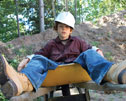On May 4, 2007, Greensburg, Kan., was hit by a devastating tornado that leveled 39 blocks and destroyed 95 percent of the community with winds of more than 200 mph. The tornado was classified as an EF5, the highest rating on the Enhanced Fujita tornado damage scale.
Contemplating the rebuilding effort, City Administrator Steve Hewitt and other town leaders faced a harsh reality: Greensburg had been struggling for many years before the tornado because of a lack of economic opportunity. The city's population had steadily declined since 1960, and, according to the 2000 Census, the median age of Greensburg residents was 45.6, more than 10 years older than the overall median age in the U.S. The town's leaders and residents decided to treat the tragedy as an opportunity to reinvent Greensburg.
To live up to their city's name, Greensburg residents decided to rebuild a more sustainable, eco-friendly town that could serve as a model green community for the future. The city council passed a policy resolution stating all new city buildings would be constructed to meet U.S. Green Building Council LEED® Platinum standards; it was the first city in the U.S. to pass such a resolution.
Among the new buildings to be constructed was Kiowa County Commons, which was intended to replace the decimated Kiowa County Library and Historical Museum. The building also was to house a Community Media Center and Kansas State Extension Service. GLMV Architecture Inc., Wichita, Kan., was hired as the project's architect, and Compton Construction Corp., Wichita, was hired as general contractor.
To achieve as many points as possible toward LEED Platinum certification, the building was to receive a low-slope reflective cool roof system, vegetative roof system and building-integrated photovoltaic (PV) systems.
"The project was put up for public bid; however, we had done work in Greensburg in the past with the same general contractor and architect, and they came to us during the project's design phase," says Marc Cameron, project manager for Dodge City, Kan.-based Diamond Roofing and Diamond Solar Solutions, based out of Diamond Roofing's office in Manhattan, Kan.
The companies, which share common ownership, won the bid and were hired to install the roof systems on Kiowa County Commons.
Meeting expectations
Roofing work at Kiowa County Commons began in October 2010. An AES Raptor guardrail fall-protection system was used at the perimeter of the large concave upper roof area at the building's south side. The lower roof area was surrounded by a 5-foot-tall parapet wall, which simplified fall protection but required a crane to raise and lower materials to the roof.
On the upper roof area, Diamond Roofing crew members attached two layers of 2 1/2-inch-thick polyisocyanurate roof insulation to the acoustical metal deck, which has batt insulation laid in the flutes. A 1/2-inch-thick layer of Firestone Building Products' DensDeck Prime was adhered to the insulation, followed by a fully adhered Sika Sarnafil Décor rib PVC roof system.
On the lower roof area, crew members adhered 1/2-inch-thick DensDeck Prime to tapered polyisocyanurate, whichwas attached to the acoustical metal deck with batt insulation laid in the deck's flutes. Next, the crew adhered a Firestone Building Products 60-mil-thick TPO membrane to the DensDeck Prime followed by a vegetative LiveRoof.®
"The vegetative roof system was installed in June 2011," Cameron says. "The LiveRoof trays had been growing since August 2010—they had nearly a year's worth of growth before being delivered to the job site."
Delivery of the trays required specific coordination.
"The LiveRoof trays arrived in five truckloads in preloaded hoppits," Cameron says. "Manpower and coordination of the trucks' arrival was critical to meet expectations."
For the raised concave PV platforms, GLMV Architecture originally specified adhering PV laminates to a 60-mil-thick single-ply PVC membrane; however, it did not consider potential heat degradation concerns with adhered PV laminates.
"Although the LEED rating system does an excellent job providing a ‘big picture' benchmark for the design, construction and operation of green buildings, its point system approach fails to recognize the broader roofing context and importance of durability," says Kevin Gwaltney, Diamond Roofing's president.
Diamond Solar Solutions requested a change order for the project recommending GAF Materials' EverGuard® Extreme™ Advanced Heat & UV Protection TPO, which the architect approved.
"On the raised platforms, crew members wearing personal fall-arrest systems adhered the EverGuard Extreme 80-mil-thick TPO to 1/2-inch-thick DensDeck Prime fastened to the metal deck," Cameron says. "Uni-Solar® thin-film PV laminates then were adhered to the TPO membrane in late spring 2011."
Overcoming challenges
Work at Kiowa County Commons presented some specific challenges.
"Perhaps the most challenging aspect of the project was coordinating with the building's electrical contractor," Cameron says. "The electrical contractor had little, if any, PV installation experience, which required special attention on our part and extra time for education, oversight and testing."
According to Cameron, the PV installation was challenging overall.
"In general, the PV installation was tricky because the arrays were installed on elevated concave platforms that were not easily accessible," he says. "Ladders and scaffolding, as well as secure and reliable fall protection, were required. Most PV applications cannot be installed in one mobilization, so additional mobilizations were required, which occurred subsequent to the LiveRoof installation. Maneuvering around and being sensitive to the LiveRoof for the remainder of the PV installation was critical."
Additionally, extra coordination was required between the various trades working on the building.
"The roof area was required for staging and installing wall panels and stone parapet caps, as well as work performed by electrical and mechanical trades," Cameron says. "Protecting the installed roof membrane was of utmost importance. Additionally, extra coordination and communication were required because installation of the vegetative roof system and the PV application were unfamiliar to the other construction trades."
A city rebuilt
The roof systems at Kiowa County Commons were completed in June 2011. In addition to its PV roof towers and vegetative roof system, the building boasts 48 geothermal wells, several light monitors, insulated concrete form block construction, a rainwater collection system and energy-saving windows. It is expected to reduce the energy use of a traditionally built facility of the same size by 40 percent.
It has been more than four years since the tornado left Greensburg in ruins, and in that time, the city has lived up to its motto: "Stronger, Better, Greener!" However, rebuilding continues; the city's redevelopment is slated to take place during a 20-year period.
The Planet Green television network and actor Leonardo DiCaprio teamed up to produce a series titled "Greensburg" that documented Greensburg's rebuilding process. The show aired June 15, 2008, and ran for three seasons, ending May 3, 2010. Additionally, Budget Travel featured the city in its September article, "10 Coolest Small Towns in America 2011."
For Diamond Roofing and Diamond Solar Solutions, being a part of this benchmark project was a memorable experience.
"The aesthetic appeal of the project with its three different roof systems was unique," Cameron says. "It was rewarding to contribute to the city of Greensburg with a model of sustainability and achievement in green roofing practice."
Ashley St. John is Professional Roofing's associate editor.
Project name: Kiowa County Commons
Project location: Greensburg, Kan.
Project duration: October 2010-June 2011
Roof system types: TPO, vegetative, photovoltaic
Roofing contractors: Diamond Roofing, Dodge City, Kan., and Diamond Solar
Solutions, Manhattan, Kan.
Product manufacturers: GAF Materials Corp., Wayne, N.J.;
Firestone Building Products LLC, Indianapolis; LiveRoof® LLC, Spring Lake, Mich.;
Sika Sarnafil, Canton, Mass.; and United Solar Ovonic LLC, Auburn Hills, Mich.



